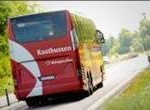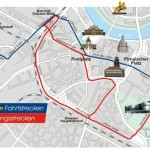Sustainable transport: how to do it? 12 good examples

Exchange of experience within SustraMM – Sustainable transports for managing mobility – one of the six approved sub-projects from EnercitEE’s 1st call
The exchange of experience on implemented mobility management measures between participating regions was carried out by SustraMM sub-project participants who collected and presented good practice examples. The good practices presented cover a wide range of topics, such as programs encouraging car commuters to use public transport, the support of bicycle traffic, mobility management measures implemented by companies, and training and outreach programs.

Photo provided by Blekingetrafiken
Several mobility measures with the objective to encourage car commuters to use public transport were presented. In particular, the City of Cluses, France, is reorganizing four bus lines and offering free ridership in order to attract new commuters and to motivate higher usage of public transport. Furthermore, in Sweden, the Blekingetrafiken (public transport provider) offers free ridership during the first one to two months of usage to all car drivers that are willing to use public transport instead of driving to work. Additionally, educational and outreach activities are seen in programs such as The Blekinge Trip, in Sweden. The program is focusing on “the travellers of tomorrow” (i.e. 12-year-olds) by providing hands-on-experience on how to effectively use different means of public transportation and get to the desired destination. Students, traveling in small groups of four to seven people, typically plan a day trip by using buses and/or trains and afterwards they present their trip report in school.
Mobility measures aimed to support bicycle traffic are noted in the region around Pirna, Saxony, Germany, where “cycle buses”, which can carry around 20 bikes, are offered to help and support bicycle riders to travel longer distances. This attractive and comfortable public offer also combines existing local transport services with the emerging bicycle tourism. Likewise, the City of Cluses, France, promotes non-motorized transportation by launching the Green Lane from Leman to Mont-Blanc, which is a driveway reserved exclusively for non-motorized vehicles and pedestrians. Another good practice example that focuses on increasing bicycle ridership is that of the Energikontor Sydost in Sweden, regional energy agency. The agency’s objective is to increase the bicycle modal share of commuting trips by implementing competitive and incentive bicycle commuting programs among participating companies. The programs are designed to reduce ”un-needed” car driving and to change driving habits. Specifically, the Sydost Trampar project is a competition in which bicycle teams from different companies compete in their everyday commute.
As far as the mobility management measures implemented by companies, two good practice examples come from Dresden, Germany. The first is by the company Infineon, which implemented a variety of measures for their employees, such as the Infineon-Ticket which reduces the ticket price for public transport; car sharing support; and the improvement of cycling facilities. As a conse-quence of these efforts, the company modal share is modified in favour of eco-friendly traffic. The employees save money on transportation, while the company benefits by avoiding the need to build additional multi-level car park. The second example of successful implementation of sustainable transportation measures comes from Volkswagen manufacturing facility in Dresden and their CarGo Tram. Instead of transporting the freight in trucks, a blue CarGo Tram delivers the required supplies from the train station to the factory, which is located in the city centre. Hence, by using the existing public tram network infrastructure, CarGo Tram mitigates heavy duty transport, as well as reduces emissions of common pollutants.
(Photo: http://www.dvb.de/de/Die-DVB-AG/Zahlen—Daten/CarGoTram/)
The following set of good practice examples affect different application fields, as well as promote awareness. To introduce the concept of sustainable transportation to young people, the City of Cluses, France, promotes transport sustainability on events such as Musiques en stock. Among other actions and promotions, the city provides bicycle racks and helps initiate car sharing programs. Additionally, the city offers training on eco-responsibility and sustainability to city officials, which can become a role model for sustainable transportation. Next, the Energikontor Sydost in Sweden founded platforms for the collaboration of stakeholders on Mobility Management projects and activities with the aim to reduce CO2 emissions (“fuel free by 2050”). These programs focus on helping and supporting stakeholders with the goal to achieve a sustainable transport sector. Finally, in the State of Saxony, Germany, an internet-based exchange platform is developed to reduce the cost of daily travel and hence reduce the individual traffic and protect the environment. The program supports carpooling to work, and leisure destinations as well.
Article written by Torsten Belter and Maike Harten from the Technical University of Dresden.







